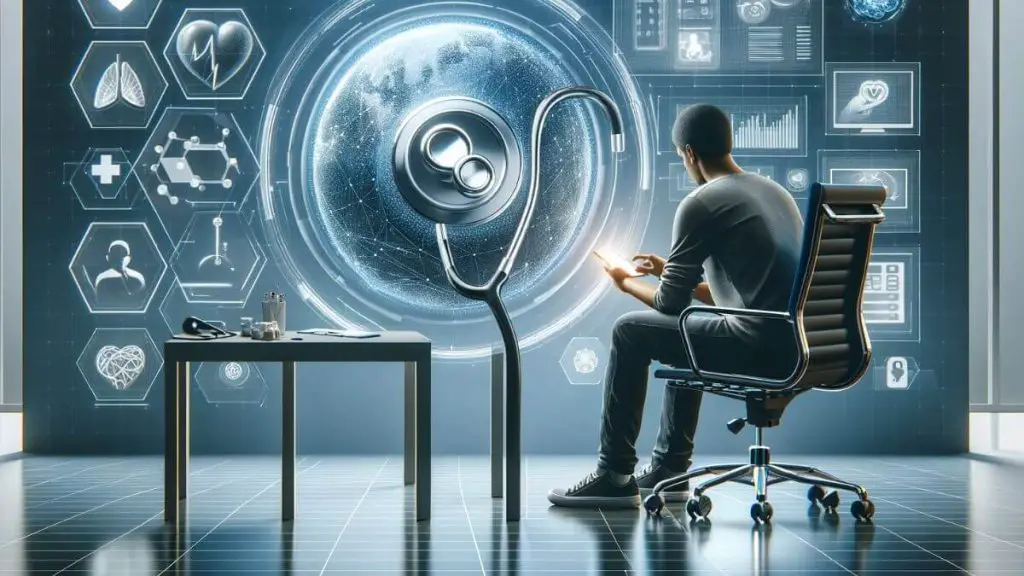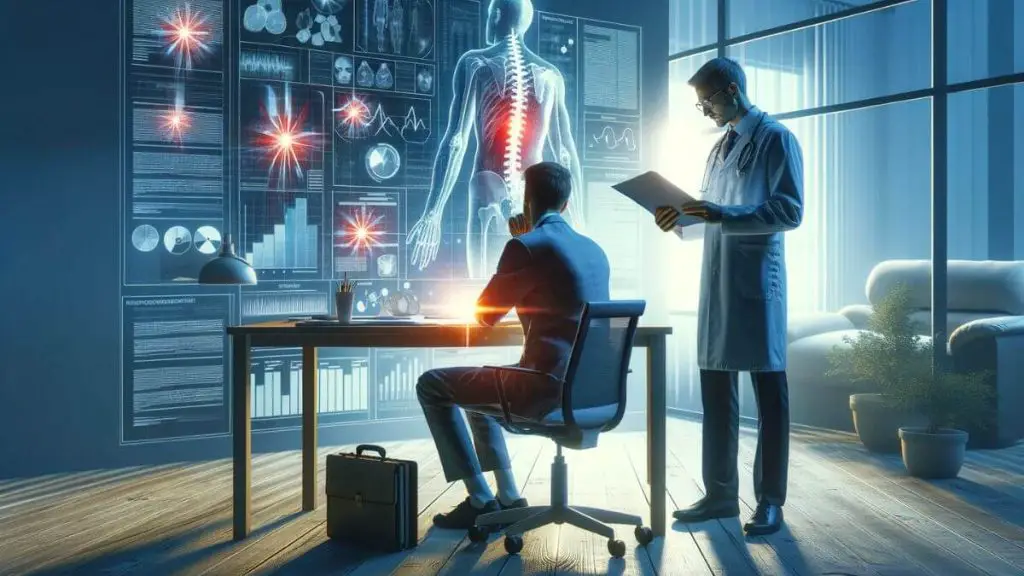101 Tips for Mental Wellness in Chronic Pain
As a man who has witnessed the relentless battle against chronic pain, I’ve come to understand its profound impact not just on the sufferer but on their loved ones as well. This is why I decided to list 101 tips for mental wellness in chronic pain.
Mental wellness in chronic pain involves managing the psychological impact of long-term pain. It includes techniques like mindfulness, stress reduction, counseling, and building support networks to improve coping strategies and enhance overall well-being.
My role as a husband changed after my wife became chronically ill. It wasn’t easy to begin with, but her resilience gave me the strength to carry on. After all, I have everything I ever needed to be happy – my health.
In the next part, I give you a short story of mine, which you can fully read on my personal page. In the meantime, take a look at the video below that belongs to my YouTube channel related to endometriosis, fibromyalgia, and overall chronic illness and chronic pain.
- My Personal Story
- 101 Tips for Mental Wellness in Chronic Pain
- 101 Tips for Mental Wellness in Chronic Pain with Details
- 1. How Can Deep Breathing Help Manage Chronic Pain?
- 2. What Role Does Regular Exercise Play in Pain Management?
- 3. How Can a Healthy Diet Impact Chronic Pain?
- 4. What Is the Importance of Hydration in Pain Management?
- 5. How Does Sleep Affect Chronic Pain?
- 6. Can Mindfulness Meditation Reduce Chronic Pain?
- 7. What is the Role of Support Groups in Chronic Pain Management?
- 8. How Can Journaling Aid in Managing Chronic Pain?
- 9. What is the Importance of Setting Realistic Goals?
- 10. How Does Positive Thinking Impact Chronic Pain?
- 11. Can Aromatherapy Help in Reducing Chronic Pain?
- 12. Why is Time Management Important in Chronic Pain?
- 13. How Can Art Therapy Ease Chronic Pain?
- 14. What Is the Benefit of Listening to Music for Pain Relief?
- 15. How Does Pet Therapy Assist in Managing Chronic Pain?
- 16. Why Is Maintaining Social Connections Important in Pain Management?
- 17. Can Acupuncture Aid in Reducing Chronic Pain?
- 18. How Does Heat Therapy Relieve Chronic Pain?
- 19. What Are the Benefits of Cold Therapy for Pain Management?
- 20. How Important Is Professional Counseling for Chronic Pain?
- 21. Can Guided Imagery Provide Relief from Chronic Pain?
- 22. Why Is a Routine Important for Managing Chronic Pain?
- 23. How Does Volunteering Benefit Those with Chronic Pain?
- 24. Can Yoga Help in Managing Chronic Pain?
- 25. What is the Importance of Celebrating Small Victories?
- 26. How Can Gardening Assist in Chronic Pain Management?
- 27. Why Is Staying Informed About Your Condition Important?
- 28. How Does Learning a New Skill or Hobby Impact Chronic Pain?
- 29. What Is the Benefit of Regular Check-Ups With Health Professionals?
- 30. How Can Technology Aid in Managing Chronic Pain?
- 30. How Can Technology Aid in Managing Chronic Pain?
- 31. Why Is It Important to Understand Your Pain Triggers?
- 32. How Does Progressive Muscle Relaxation Help in Pain Management?
- 33. What Role Does Humor Play in Coping with Chronic Pain?
- 34. How Can Cognitive Behavioral Therapy (CBT) Assist in Pain Management?
- 35. Why Is Balancing Rest and Activity Important in Pain Management?
- 36. How Does Building a Pain Management Team Benefit You?
- 37. Can Physical Therapy Reduce Chronic Pain?
- 38. Why Is it Important to Advocate for Your Health?
- 39. How Can Tai Chi Benefit People with Chronic Pain?
- 40. What Is the Role of Nutrition Supplements in Pain Management?
- 41. How Does Positive Self-Talk Influence Pain Perception?
- 42. Why Is it Beneficial to Learn Relaxation Techniques?
- 43. Can Hydrotherapy Provide Relief for Chronic Pain?
- 44. How Does Establishing a Pain Diary Aid in Managing Chronic Pain?
- 45. What Are the Benefits of Massage Therapy for Chronic Pain?
- 46. Why Is It Important to Maintain a Healthy Weight for Pain Management?
- 47. Can Heat and Cold Therapy Be Used Together for Pain Relief?
- 48. How Does Practicing Gratitude Impact Chronic Pain?
- 49. What Is the Role of Heat Patches and Capsaicin Creams in Pain Relief?
- 50. How Can Breathwork Techniques Alleviate Chronic Pain?
- 51. Why Is It Important to Break Down Activities into Manageable Steps?
- 52. How Can Mind-Body Therapies Like Biofeedback Help in Pain Management?
- 53. What Are the Benefits of a Warm Bath for Chronic Pain?
- 54. How Can Creating Art Be Therapeutic for Chronic Pain Patients?
- 55. Why Is Finding a Pain Management Strategy That Works for You Important?
- 56. How Can Music Therapy Enhance Pain Management?
- 57. What Is the Importance of Flexibility Exercises in Chronic Pain Management?
- 58. How Does Proper Posture Contribute to Reducing Chronic Pain?
- 59. Why Is It Beneficial to Explore Different Pain Relief Options?
- 60. Can Visualization Techniques Reduce the Perception of Pain?
- 61. How Does Engaging in Low-Impact Aerobic Exercises Benefit Chronic Pain?
- 62. Why Is It Important to Stay Active Despite Chronic Pain?
- 63. How Can Mindful Eating Habits Impact Chronic Pain?
- 64. What Is the Role of Occupational Therapy in Managing Chronic Pain?
- 65. How Can Keeping a Regular Sleep Schedule Aid in Pain Management?
- 66. Why Is It Essential to Communicate Openly with Healthcare Providers About Your Pain?
- 67. How Can Heat and Light Therapy Be Used to Manage Chronic Pain?
- 68. What Are the Psychological Benefits of Regular Physical Activity for Chronic Pain Sufferers?
- 69. How Can Building Resilience Help in Coping with Chronic Pain?
- 70. Why Is It Beneficial to Establish a Morning Routine for Pain Management?
- 71. How Can Practicing Self-Compassion Aid in Managing Chronic Pain?
- 72. What Is the Importance of Personal Boundaries in Chronic Pain Management?
- 73. How Can Creative Writing Be Used as a Tool for Pain Management?
- 74. Why Is Hydration Important for Individuals with Chronic Pain?
- 75. How Can Socializing Help Manage Chronic Pain?
- 76. What Is the Role of Spirituality or Religion in Managing Chronic Pain?
- 77. How Does Reducing Stress Impact Chronic Pain?
- 78. What Are the Benefits of Participating in Water Aerobics for Chronic Pain?
- 79. Why Is It Important to Focus on What You Can Control in Managing Chronic Pain?
- 80. How Can Laughter Yoga Benefit Individuals with Chronic Pain?
- 81. What Is the Importance of Regularly Reviewing and Adjusting Pain Management Plans?
- 82. How Does Engaging in Community Service Impact Chronic Pain?
- 83. Why Is Keeping Up with Current Research and Treatments for Chronic Pain Important?
- 84. How Can Indoor Plants Improve the Living Environment for Those with Chronic Pain?
- 85. What Is the Role of Alternative Therapies Like Reiki in Pain Management?
- 86. How Can Participating in Supportive Online Communities Benefit Chronic Pain Management?
- 87. Why Is It Beneficial to Explore Artistic Outlets Like Photography or Painting?
- 88. How Can Learning About Pain Science Improve Pain Management?
- 89. What Are the Benefits of Guided Relaxation Sessions for Chronic Pain?
- 90. Why Is It Important to Celebrate Progress in Pain Management?
- 91. How Can Practicing Patience Aid in Coping with Chronic Pain?
- 92. What Is the Impact of Positive Visualization on Pain Levels?
- 93. How Does Engaging in Regular Recreational Activities Benefit Those with Chronic Pain?
- 94. Why Is It Crucial to Have a Support System for Chronic Pain Management?
- 95. What Are the Advantages of Integrative Medicine Approaches in Managing Chronic Pain?
- 96. How Can Regular Reflexology Sessions Assist in Pain Management?
- 97. Why Is Self-Education About Medications and Their Side Effects Important?
- 98. How Can Gardening Therapy Be Beneficial for Those with Chronic Pain?
- 99. What Is the Role of Deep Tissue Massage in Managing Chronic Pain?
- 100. How Can Attending Workshops and Seminars on Chronic Pain Management Be Helpful?
- 101. Why Is It Beneficial to Practice Gentle Stretching Exercises Daily?
- Conclusion on 101 Tips for Mental Wellness in Chronic Pain
My Personal Story
When giving tips for mental wellness in chronic pain, it’s always worth taking advice from people who are in the position to talk or/and write about it.
My journey began as a husband, standing beside my wife who endures the unyielding challenges of endometriosis and fibromyalgia.
Watching her cope with the daily struggles, the unspoken pains, and the emotional turmoil, I realized that the battle against chronic pain is not just physical – it’s a mental and emotional marathon.
Witnessing her strength and resilience, yet also her moments of vulnerability, sparked in me a deep desire to contribute, to find ways to ease not just her physical symptoms, but the mental and emotional weight that comes with them.
This pursuit led me to compile “101 Tips for Mental Wellness in Chronic Pain”, a comprehensive guide born from extensive research, personal experiences, and a heartfelt understanding of what it means to live with and love someone with, chronic pain. The decision to write this was driven by more than just personal motivation and was fuelled by the realization that our story is not unique.
Countless individuals and families confront the realities of chronic pain daily. This guide is my effort to reach out to them, to offer a resource that can bring comfort, understanding, and practical strategies for navigating the intricate interplay of mind and body in the realm of chronic pain.
Each tip in this collection is a testament to the resilience of the human spirit and an acknowledgment of the complex challenges faced by those living with chronic pain and their supportive partners. It’s a guide that I hope will bring light to dark days, provide relief in moments of overwhelming pain, and most importantly, offer a sense of companionship and understanding to anyone who walks this path.
As you delve into these tips for mental wellness in chronic pain, remember that each journey is unique, and what works for one may not work for another.
My aim is to provide a diverse range of strategies, so you can find the ones that resonate most with your experience. This compilation is more than just a list; it’s a testament to love, patience, and unwavering support – the core values that guide us through the complexities of chronic pain.
If you want more in-depth information about how to support your partner with her chronic conditions and how to cope with the new normal in your relationship, I wrote a “Supporting a Chronically Ill Partner” e-Book.
You can get the 1st Chapter of the e-Book for FREE, and if you like it, you’ll get a Whopping 33% Discount on the Whole Book, plus discounts on other helpful tools. You have nothing to lose but a lot to gain!
The first chapter alone contains a lot of information for both of you about acknowledging the struggles, including:
- A word to your partner.
- A word to you.
- Stepping on eggshells.
- Understanding her needs.
- How to acknowledge having a chronically ill partner?
- Acknowledging can be hard.
- 15 tips on how to do it!
Get the 1st Chapter FREE!
Chronic Illness for Partners

101 Tips for Mental Wellness in Chronic Pain
I begin by giving you the whole list, and later on expand on all 101 tips for mental wellness in chronic pain.
Here they are:
- How can deep breathing help manage chronic pain?
- What role does regular exercise play in pain management?
- How can a healthy diet impact chronic pain?
- What is the importance of hydration in pain management?
- How does sleep affect chronic pain?
- Can mindfulness meditation reduce chronic pain?
- What is the role of support groups in chronic pain management?
- How can journaling aid in managing chronic pain?
- What is the importance of setting realistic goals?
- How does positive thinking impact chronic pain?
- Can aromatherapy help in reducing chronic pain?
- Why is time management important in chronic pain?
- How can art therapy ease chronic pain?
- What is the benefit of listening to music for pain relief?
- How does pet therapy assist in managing chronic pain?
- Why is maintaining social connections important in pain management?
- Can acupuncture aid in reducing chronic pain?
- How does heat therapy relieve chronic pain?
- What are the benefits of cold therapy for pain management?
- How important is professional counseling for chronic pain?
- Can guided imagery provide relief from chronic pain?
- Why is a routine important for managing chronic pain?
- How can gardening assist in chronic pain management?
- Why is staying informed about your condition important?
- How does learning a new skill or hobby impact chronic pain?
- What is the benefit of regular check-ups with health professionals?
- How can technology aid in managing chronic pain?
- Why is it important to understand your pain triggers?
- How does progressive muscle relaxation help in pain management?
- What role does humor play in coping with chronic pain?
- How can cognitive behavioral therapy (CBT) assist in pain management?
- Why is balancing rest and activity important in pain management?
- How does building a pain management team benefit you?
- Can physical therapy reduce chronic pain?
- Why is it important to advocate for your health?
- How can tai chi benefit people with chronic pain?
- What is the role of nutrition supplements in pain management?
- How can positive self-talk influence pain perception?
- Why is it beneficial to learn relaxation techniques?
- Can hydrotherapy provide relief for chronic pain?
- How does establishing a pain diary aid in managing chronic pain?
- What are the benefits of massage therapy for chronic pain?
- Why is it important to maintain a healthy weight for pain management?
- Can heat and cold therapy be used together for pain relief?
- How does practicing gratitude impact chronic pain?
- What is the role of heat patches and capsaicin creams in pain relief?
- How can breathwork techniques alleviate chronic pain?
- Why is it important to break down activities into manageable steps?
- How can mind-body therapies like biofeedback help in pain management?
- What are the benefits of a warm bath for chronic pain?
- How can creating art be therapeutic for chronic pain patients?
- Why is finding a pain management strategy that works for you important?
- How can music therapy enhance pain management?
- What is the importance of flexibility exercises in chronic pain management?
- How does proper posture contribute to reducing chronic pain?
- Why is it beneficial to explore different pain relief options?
- Can visualization techniques reduce the perception of pain?
- How does engaging in low-impact aerobic exercises benefit chronic pain?
- Why is it important to stay active despite chronic pain?
- How can mindful eating habits impact chronic pain?
- What is the role of occupational therapy in managing chronic pain?
- How can keeping a regular sleep schedule aid in pain management?
- Why is it essential to communicate openly with healthcare providers about your pain?
- How can heat and light therapy be used to manage chronic pain?
- What are the psychological benefits of regular physical activity for chronic pain sufferers?
- How can building resilience help in coping with chronic pain?
- Why is it beneficial to establish a morning routine for pain management?
- How can practicing self-compassion aid in managing chronic pain?
- What is the importance of personal boundaries in chronic pain management?
- How can creative writing be used as a tool for pain management?
- Why is hydration important for individuals with chronic pain?
- How can socializing help manage chronic pain?
- What is the role of spirituality or religion in managing chronic pain?
- How does reducing stress impact chronic pain?
- What are the benefits of participating in water aerobics for chronic pain?
- Why is it important to focus on what you can control in managing chronic pain?
- How can laughter yoga benefit individuals with chronic pain?
- What is the importance of regularly reviewing and adjusting pain management plans?
- How does engaging in community service impact chronic pain?
- Why is keeping up with current research and treatments for chronic pain important?
- How can indoor plants improve the living environment for those with chronic pain?
- What is the role of alternative therapies like reiki in pain management?
- How can participating in supportive online communities benefit chronic pain management?
- Why is it beneficial to explore artistic outlets like photography or painting?
- How can learning about pain science improve pain management?
- What are the benefits of guided relaxation sessions for chronic pain?
- Why is it important to celebrate progress in pain management?
- How can practicing patience aid in coping with chronic pain?
- What is the impact of positive visualization on pain levels?
- How does engaging in regular recreational activities benefit those with chronic pain?
- Why is it crucial to have a support system for chronic pain management?
- What are the advantages of integrative medicine approaches in managing chronic pain?
- How can regular reflexology sessions assist in pain management?
- Why is self-education about medications and their side effects important?
- How can gardening therapy be beneficial for those with chronic pain?
- What is the role of deep tissue massage in managing chronic pain?
- How can attending workshops and seminars on chronic pain management be helpful?
- How can practicing gentle stretching exercises daily benefit those with chronic pain?
- How can learning to manage stress effectively assist in chronic pain management?
- What are the benefits of aqua therapy for individuals with chronic pain?
- Why is it important to seek regular mental health support when dealing with chronic pain?
Here they are, 101 tips for mental wellness in chronic pain. Now, let me expand on all of them one by one…
101 Tips for Mental Wellness in Chronic Pain with Details
These tips for mental wellness in chronic pain encompass a variety of strategies and considerations for managing chronic pain, highlighting the importance of a comprehensive and personalized approach that addresses both the physical and mental aspects of pain management.
Let’s begin…

1. How Can Deep Breathing Help Manage Chronic Pain?
Deep breathing exercises can significantly aid in managing chronic pain. This technique involves slow, controlled breathing, which helps in relaxing muscle tension and reducing stress, common factors that exacerbate pain. By focusing on breath, the mind shifts attention away from pain, offering a natural method of pain relief. Regular practice can enhance overall mental wellness and pain management.
2. What Role Does Regular Exercise Play in Pain Management?
Regular exercise is crucial in managing chronic pain. It releases endorphins, the body’s natural painkillers, which can reduce pain perception. Gentle exercises like walking, swimming, or yoga can improve strength, flexibility, and mood, and decrease the severity of pain. Consistency in exercise routines is key for long-term benefits.
3. How Can a Healthy Diet Impact Chronic Pain?
A healthy diet plays a vital role in managing chronic pain. Foods rich in omega-3 fatty acids, like fish and nuts, can reduce inflammation, a common cause of pain. Additionally, maintaining a balanced diet helps in weight management, reducing stress on joints and minimizing pain. Avoiding inflammatory foods such as processed items can also contribute to pain reduction.
4. What Is the Importance of Hydration in Pain Management?
Staying hydrated is essential for individuals with chronic pain. Adequate water intake ensures proper circulation, joint lubrication, and toxin elimination, all of which can mitigate pain. Dehydration can lead to increased pain sensitivity and muscle cramps, exacerbating pain conditions. It is recommended to drink enough water daily to support bodily functions and pain management.
5. How Does Sleep Affect Chronic Pain?
Quality sleep is fundamental in managing chronic pain. Poor sleep can increase pain sensitivity, reduce pain tolerance, and exacerbate inflammation. Establishing a regular sleep schedule, creating a comfortable sleep environment, and avoiding caffeine before bedtime can improve sleep quality, thereby aiding in pain management.
6. Can Mindfulness Meditation Reduce Chronic Pain?
Mindfulness meditation can be an effective tool in reducing chronic pain. It involves focusing on the present moment and accepting pain without judgment. This practice can alter pain perception, reduce stress and anxiety, and improve emotional response to pain. Regular mindfulness meditation has been shown to have long-term benefits for pain management and mental wellness.
7. What is the Role of Support Groups in Chronic Pain Management?
Support groups play a crucial role in chronic pain management. Sharing experiences with others who understand can provide emotional support, reduce feelings of isolation, and offer practical advice for coping with pain. Support groups can also be a source of motivation and provide a sense of community, enhancing mental wellness.
8. How Can Journaling Aid in Managing Chronic Pain?
Journaling can be a therapeutic tool in managing chronic pain. Writing about daily experiences and feelings helps in processing emotions, identifying pain patterns, and tracking treatment progress. It offers a healthy outlet for expressing pain-related frustrations, leading to improved mental well-being.
9. What is the Importance of Setting Realistic Goals?
Setting realistic goals is important in chronic pain management. Achievable goals provide a sense of purpose and direction, enhancing motivation and self-esteem. They should be specific, measurable, and time-bound, focusing on gradual progress rather than immediate results. Celebrating small achievements can boost morale and encourage continued effort.

10. How Does Positive Thinking Impact Chronic Pain?
Positive thinking can significantly impact the management of chronic pain. Adopting a positive mindset helps in coping with pain more effectively, reduces stress, and improves overall mental health. Focusing on abilities rather than limitations, and practicing gratitude can shift the perception of pain and enhance life quality.
11. Can Aromatherapy Help in Reducing Chronic Pain?
Aromatherapy can be beneficial in reducing chronic pain. Essential oils like lavender, peppermint, and eucalyptus have properties that can relieve pain, reduce inflammation, and promote relaxation. Inhaling these scents or using them in massages can trigger positive sensory responses in the brain, alleviating pain and improving mood. Regular use of aromatherapy as a complementary therapy can enhance the overall pain management strategy.
12. Why is Time Management Important in Chronic Pain?
Effective time management is important in chronic pain management. Balancing activities and rest periods prevents overexertion and pain flare-ups. Prioritizing tasks, setting achievable daily goals, and taking regular breaks can reduce stress and physical strain. Good time management also ensures adequate time for relaxation and self-care, essential for mental wellness.
13. How Can Art Therapy Ease Chronic Pain?
Art therapy can be a powerful tool to ease chronic pain. Engaging in creative activities like painting, drawing, or sculpting offers a distraction from pain, reduces stress, and allows for emotional expression. This form of therapy can improve mood, enhance cognitive function, and provide a sense of accomplishment, contributing positively to pain management.
14. What Is the Benefit of Listening to Music for Pain Relief?
Listening to music can offer significant relief from chronic pain. It can distract the mind from pain signals, lower stress, and evoke emotional responses that can release endorphins, reducing pain perception. Soothing music, in particular, can relax the mind and body, aiding in pain management and improving overall well-being.
15. How Does Pet Therapy Assist in Managing Chronic Pain?
Pet therapy can assist significantly in managing chronic pain. Interacting with pets has been shown to reduce pain levels, alleviate stress, and improve mood. The companionship of a pet can also offer emotional support, reduce feelings of loneliness, and encourage physical activity, all of which are beneficial in pain management.
16. Why Is Maintaining Social Connections Important in Pain Management?
Maintaining social connections is vital in chronic pain management. Social interactions can provide emotional support, reduce feelings of isolation, and offer distractions from pain. Engaging in social activities can improve mood and mental health, thereby indirectly helping to manage pain more effectively.
17. Can Acupuncture Aid in Reducing Chronic Pain?
Acupuncture can aid in reducing chronic pain. This traditional Chinese medicine technique involves inserting thin needles into specific points on the body to release blocked energy. It can stimulate nerves, muscles, and connective tissue, enhancing blood flow and triggering the body’s natural painkillers. Many find acupuncture effective in managing various types of chronic pain.
18. How Does Heat Therapy Relieve Chronic Pain?
Heat therapy is a simple yet effective way to relieve chronic pain. Applying heat to painful areas can increase blood flow, relax muscles, and soothe discomfort. Heat pads, warm baths, or heated blankets can be used for this purpose. This method is particularly effective for muscle stiffness and joint pain.
19. What Are the Benefits of Cold Therapy for Pain Management?
Cold therapy can be beneficial for pain management, especially for inflammatory pain. Applying cold packs to affected areas can reduce inflammation, numb nerve endings, and decrease swelling, providing relief from pain. It is often used for acute injury pain but can be part of a chronic pain management strategy.

20. How Important Is Professional Counseling for Chronic Pain?
Professional counseling is highly important for individuals with chronic pain. Counselors or psychologists can provide strategies to cope with the emotional and psychological aspects of living with chronic pain. Cognitive-behavioral therapy (CBT), in particular, can help in changing negative thought patterns and improving coping mechanisms, thereby enhancing mental wellness.
21. Can Guided Imagery Provide Relief from Chronic Pain?
Guided imagery can provide significant relief from chronic pain. This technique involves visualizing calming and positive images, which can help the mind focus away from pain. It can reduce stress, improve mood, and alter the perception of pain. Practicing guided imagery regularly can be a valuable tool in a comprehensive pain management plan.
22. Why Is a Routine Important for Managing Chronic Pain?
Establishing a routine is crucial for managing chronic pain. A consistent schedule for sleep, meals, exercise, and medication can help maintain the body’s balance and reduce unexpected pain flare-ups. A routine also provides a sense of control and predictability, which can alleviate anxiety and stress associated with chronic pain.
23. How Does Volunteering Benefit Those with Chronic Pain?
Volunteering can offer significant benefits for those with chronic pain. It provides a sense of purpose, enhances self-esteem, and offers opportunities for social interaction. Engaging in meaningful activities can distract from pain and contribute to a positive mindset. Volunteering can also foster a sense of community and support, which is beneficial for mental wellness.
24. Can Yoga Help in Managing Chronic Pain?
Yoga can be highly effective in managing chronic pain. It combines physical postures, breathing exercises, and meditation to enhance flexibility, strength, and mental focus. Regular yoga practice can reduce pain, improve mobility, and lower stress levels, contributing to overall pain management and mental wellness.
25. What is the Importance of Celebrating Small Victories?
Celebrating small victories is important in chronic pain management. Acknowledging progress, no matter how minor, boosts morale and motivation. It helps in focusing on positive aspects and achievements, rather than limitations. Celebrating these moments can enhance mental well-being and encourage persistence in pain management efforts.
26. How Can Gardening Assist in Chronic Pain Management?
Gardening can assist in chronic pain management by providing gentle physical activity, which can improve strength and flexibility. The act of nurturing plants can offer a sense of accomplishment and joy. Additionally, being outdoors and in nature can reduce stress and promote relaxation, beneficial for both physical and mental wellness.
27. Why Is Staying Informed About Your Condition Important?
Staying informed about your chronic pain condition is vital. Understanding the nature of your pain, treatment options, and management strategies empowers you to make informed decisions about your health. Knowledge can reduce anxiety about the unknown, help in recognizing symptoms, and facilitate effective communication with healthcare providers.
28. How Does Learning a New Skill or Hobby Impact Chronic Pain?
Learning a new skill or hobby can positively impact chronic pain management. It provides a sense of accomplishment, boosts self-esteem, and offers a distraction from pain. Engaging in activities that interest you can also reduce stress and improve mental health, which are crucial for managing chronic pain.
29. What Is the Benefit of Regular Check-Ups With Health Professionals?
Regular check-ups with health professionals are essential for managing chronic pain. These visits allow for monitoring the condition, adjusting treatment plans, and addressing any new concerns. Consistent medical support ensures that the pain management strategy remains effective and tailored to the individual’s needs.

30. How Can Technology Aid in Managing Chronic Pain?
Technology can aid in managing chronic pain through various tools and apps designed for pain tracking, meditation, and relaxation. Virtual consultations with healthcare providers can also make it easier to receive medical advice. Using technology for pain management can offer convenience, personalized strategies, and enhance the effectiveness of treatment plans.
30. How Can Technology Aid in Managing Chronic Pain?
Technology can aid in managing chronic pain through various tools and apps designed for pain tracking, meditation, and relaxation. Virtual consultations with healthcare providers can also make it easier to receive medical advice. Using technology for pain management can offer convenience, personalized strategies, and enhance the effectiveness of treatment plans.
31. Why Is It Important to Understand Your Pain Triggers?
Understanding your pain triggers is important in chronic pain management. Knowing what exacerbates your pain helps in avoiding or mitigating these factors. It enables more effective pain management and reduces the likelihood of severe pain episodes. Being aware of triggers also assists in planning activities and managing expectations.
32. How Does Progressive Muscle Relaxation Help in Pain Management?
Progressive Muscle Relaxation (PMR) helps in managing chronic pain by reducing muscle tension, a common pain contributor. The technique involves tensing and relaxing different muscle groups, promoting relaxation and pain relief. Regular practice of PMR can also reduce stress and anxiety, improving overall mental well-being.
33. What Role Does Humor Play in Coping with Chronic Pain?
Humor plays a significant role in coping with chronic pain. Laughter can release endorphins, the body’s natural painkillers, and reduce stress hormones. It provides a psychological buffer against pain and can improve mood and resilience. Watching comedies or sharing jokes can be an effective way to incorporate humor into pain management.
34. How Can Cognitive Behavioral Therapy (CBT) Assist in Pain Management?
Cognitive Behavioral Therapy (CBT) is an effective tool in managing chronic pain. It helps in identifying and changing negative thought patterns and behaviors that exacerbate pain. CBT can improve coping strategies, reduce depression and anxiety, and enhance pain tolerance. It’s often used alongside other pain management techniques.
35. Why Is Balancing Rest and Activity Important in Pain Management?
Balancing rest and activity is crucial in pain management. Overactivity can lead to pain flare-ups, while excessive rest can weaken muscles and increase pain. Finding a balance helps in maintaining physical function and reducing pain. It’s important to listen to your body and adjust activities accordingly.
36. How Does Building a Pain Management Team Benefit You?
Building a pain management team ensures comprehensive care for chronic pain. This team can include doctors, physical therapists, psychologists, and other specialists. Collaborative care allows for a multifaceted approach to pain management, addressing both physical and psychological aspects, and providing more effective and personalized care.
37. Can Physical Therapy Reduce Chronic Pain?
Physical therapy can significantly reduce chronic pain. It involves tailored exercises and treatments that improve strength, flexibility, and function. Physical therapists can also provide education on pain management and posture correction. Consistent physical therapy can lead to long-term pain relief and improved quality of life.
38. Why Is it Important to Advocate for Your Health?
Advocating for your health is important in managing chronic pain. It involves actively participating in your healthcare, communicating effectively with providers, and seeking second opinions when necessary. Self-advocacy ensures that your needs and concerns are addressed, leading to more effective and personalized pain management.
39. How Can Tai Chi Benefit People with Chronic Pain?
Tai Chi can benefit people with chronic pain through its gentle movements and focus on breath control. This low-impact exercise improves balance, flexibility, and strength, and has been shown to reduce pain and stress. Tai Chi’s meditative aspect also contributes to mental well-being, making it a holistic approach to pain management.

40. What Is the Role of Nutrition Supplements in Pain Management?
Nutritional supplements can play a role in managing chronic pain. Supplements like omega-3 fatty acids, vitamin D, and magnesium might help reduce inflammation and pain. However, it’s important to consult with a healthcare provider before starting any supplements, as they should complement, not replace, conventional treatments.
41. How Does Positive Self-Talk Influence Pain Perception?
Positive self-talk can significantly influence pain perception. Changing negative thoughts into positive affirmations can alter the way the brain processes pain, reducing its intensity. Positive self-talk also boosts emotional resilience and coping skills, essential for long-term pain management.
42. Why Is it Beneficial to Learn Relaxation Techniques?
Learning relaxation techniques is beneficial for chronic pain management. Techniques like meditation, deep breathing, and visualization can reduce muscle tension and stress, common exacerbators of pain. Regular practice of these techniques can improve pain tolerance and enhance mental wellness.
43. Can Hydrotherapy Provide Relief for Chronic Pain?
Hydrotherapy, involving exercises in a warm pool, can provide relief for chronic pain. The buoyancy of water reduces stress on joints and muscles, allowing for easier movement, while the warmth helps to relax muscles and increase blood flow. Hydrotherapy can be particularly beneficial for arthritis, fibromyalgia, and other musculoskeletal conditions, offering both physical and mental relaxation.
44. How Does Establishing a Pain Diary Aid in Managing Chronic Pain?
Establishing a pain diary aids in managing chronic pain by tracking pain patterns, triggers, and the effectiveness of treatments. Recording daily pain levels, activities, and emotional states can provide valuable insights for both the individual and healthcare providers. This information can lead to more tailored and effective pain management strategies.
45. What Are the Benefits of Massage Therapy for Chronic Pain?
Massage therapy offers multiple benefits for chronic pain sufferers. It can reduce muscle tension, improve circulation, and increase endorphin levels, the body’s natural pain relievers. Regular massage sessions can also reduce stress and anxiety, contributing to overall well-being and improved pain management.
46. Why Is It Important to Maintain a Healthy Weight for Pain Management?
Maintaining a healthy weight is crucial for pain management, particularly for chronic joint pain. Excess weight puts additional stress on weight-bearing joints like hips and knees, exacerbating pain. A healthy weight can reduce pain intensity, improve mobility, and decrease the risk of other health issues that can compound pain problems.
47. Can Heat and Cold Therapy Be Used Together for Pain Relief?
Heat and cold therapy can be used together for pain relief in a method called contrast therapy. Alternating between hot and cold compresses can reduce inflammation, soothe muscle tension, and improve circulation. This combination therapy can be particularly effective for sports injuries or muscle soreness.
48. How Does Practicing Gratitude Impact Chronic Pain?
Practicing gratitude can have a positive impact on chronic pain management. Focusing on positive aspects of life and expressing thankfulness can shift attention away from pain and discomfort. This positive mindset can lower stress levels and improve emotional well-being, which are important factors in pain perception.
49. What Is the Role of Heat Patches and Capsaicin Creams in Pain Relief?
Heat patches and capsaicin creams play a role in topical pain relief. Heat patches provide consistent warmth, helping to relax muscles and reduce stiffness. Capsaicin creams, derived from chili peppers, can decrease the intensity of pain signals sent to the brain. Both are easily accessible and can be effective for localized pain relief.

50. How Can Breathwork Techniques Alleviate Chronic Pain?
Breathwork techniques can alleviate chronic pain by promoting relaxation and reducing tension. Practices like diaphragmatic breathing can shift the body’s response to pain from a stress response to a relaxation response. Regular breathwork can also improve oxygenation and circulation, aiding in overall pain management.
51. Why Is It Important to Break Down Activities into Manageable Steps?
Breaking down activities into manageable steps is important for those with chronic pain to prevent overexertion and fatigue. It allows for better control over energy expenditure and pain levels. Planning and pacing activities can increase the likelihood of completing tasks successfully, enhancing a sense of accomplishment and reducing stress.
52. How Can Mind-Body Therapies Like Biofeedback Help in Pain Management?
Mind-body therapies like biofeedback can help in chronic pain management by teaching individuals to control bodily processes that are normally involuntary. Through biofeedback, patients learn to manage their response to pain, reduce muscle tension, and control stress responses. This self-regulation can lead to reduced pain perception and enhanced coping skills.
53. What Are the Benefits of a Warm Bath for Chronic Pain?
A warm bath can provide multiple benefits for chronic pain sufferers. The warmth helps to relax muscles, reduce stiffness, and soothe sore joints. Additionally, a bath can be a relaxing experience, offering a mental break from pain and stress. Adding Epsom salts or essential oils can enhance the pain-relieving effects.
54. How Can Creating Art Be Therapeutic for Chronic Pain Patients?
Creating art can be therapeutic for chronic pain patients by offering a creative outlet for expression and distraction from pain. Artistic activities like painting, sculpting, or drawing can enhance mindfulness, reduce stress, and promote emotional healing. The sense of achievement and expression through art can positively impact mental well-being and pain perception.
55. Why Is Finding a Pain Management Strategy That Works for You Important?
Finding a pain management strategy that works for you is crucial because chronic pain is a highly individualized experience. What works for one person might not work for another. A personalized approach, developed in consultation with healthcare providers, ensures that the management plan is effective, sustainable, and tailored to individual needs and lifestyles.
56. How Can Music Therapy Enhance Pain Management?
Music therapy can enhance pain management by reducing stress, lowering blood pressure, and improving mood. Listening to or creating music can be a form of emotional expression and distraction from pain. The therapeutic properties of music can induce relaxation and even alter the perception of pain, making it a valuable adjunct to traditional pain management methods.
57. What Is the Importance of Flexibility Exercises in Chronic Pain Management?
Flexibility exercises are important in chronic pain management as they help maintain joint range of motion, reduce stiffness, and improve mobility. Gentle stretching, yoga, or tai chi can increase flexibility, which in turn can decrease the risk of injury and pain exacerbation. Consistent practice can lead to long-term benefits and improved quality of life.
58. How Does Proper Posture Contribute to Reducing Chronic Pain?
Proper posture contributes to reducing chronic pain by aligning the body correctly, which reduces undue stress on muscles, joints, and ligaments. Maintaining good posture, especially when sitting or lifting objects, can prevent muscle strain and overuse injuries. Ergonomic adjustments in the workplace or at home can also aid in maintaining proper posture.
59. Why Is It Beneficial to Explore Different Pain Relief Options?
Exploring different pain relief options is beneficial because chronic pain is complex and may not respond to a single treatment approach. Trying various therapies – such as medication, physical therapy, acupuncture, or relaxation techniques – allows for discovering what combination of treatments works best for individual pain management.

60. Can Visualization Techniques Reduce the Perception of Pain?
Visualization techniques can reduce the perception of pain by using the mind to imagine a relaxing and pain-free experience. This mental distraction can shift focus away from pain and create a sense of tranquility. Regular practice of visualization can also reduce stress and anxiety, which are commonly associated with chronic pain.
61. How Does Engaging in Low-Impact Aerobic Exercises Benefit Chronic Pain?
Engaging in low-impact aerobic exercises benefits chronic pain by improving cardiovascular health, increasing endorphin levels, and enhancing overall fitness. Activities like walking, cycling, or swimming are gentle on the joints and can help in reducing pain, improving mood, and increasing energy levels.
62. Why Is It Important to Stay Active Despite Chronic Pain?
Staying active despite chronic pain is important as physical activity can prevent muscle atrophy, improve mood, and reduce the risk of other health problems. It’s crucial to find a balance between activity and rest, and to choose exercises that are manageable and enjoyable, to maintain physical function and overall well-being.
63. How Can Mindful Eating Habits Impact Chronic Pain?
Mindful eating habits can impact chronic pain by promoting better digestion, reducing inflammation, and maintaining a healthy weight. Being mindful about food choices and eating habits can ensure adequate nutrition, which is essential for the body’s healing processes and pain management.
64. What Is the Role of Occupational Therapy in Managing Chronic Pain?
Occupational therapy plays a key role in managing chronic pain by helping individuals modify their daily activities and work environment to reduce pain. Occupational therapists provide strategies for energy conservation, ergonomic improvements, and adaptive techniques, enabling patients to perform tasks more comfortably and efficiently.
65. How Can Keeping a Regular Sleep Schedule Aid in Pain Management?
Keeping a regular sleep schedule aids in pain management by ensuring consistent, quality rest. Adequate sleep is crucial for the body’s repair processes and can help reduce pain sensitivity. Establishing a regular bedtime routine and creating a comfortable sleeping environment can improve sleep quality, which is essential for coping with chronic pain.
66. Why Is It Essential to Communicate Openly with Healthcare Providers About Your Pain?
Communicating openly with healthcare providers about your pain is essential to receive appropriate care. Detailed information about pain intensity, triggers, and what alleviates it can help healthcare providers tailor treatment plans effectively. Open communication ensures that concerns are addressed and that care is aligned with the patient’s needs and goals.
67. How Can Heat and Light Therapy Be Used to Manage Chronic Pain?
Heat and light therapy can be used to manage chronic pain by improving circulation, reducing stiffness, and easing muscle spasms. Heat therapy, through heating pads or warm baths, relaxes muscles and reduces discomfort. Light therapy, particularly infrared light, can penetrate deeper into tissues and aid in healing by reducing inflammation and pain. These therapies can be a part of a comprehensive pain management plan.
68. What Are the Psychological Benefits of Regular Physical Activity for Chronic Pain Sufferers?
The psychological benefits of regular physical activity for chronic pain sufferers include improved mood, increased endorphin production, and reduced anxiety and depression. Exercise can also enhance self-esteem and provide a sense of accomplishment. Even moderate physical activity can have a significant positive impact on mental health, complementing physical pain relief strategies.
69. How Can Building Resilience Help in Coping with Chronic Pain?
Building resilience helps in coping with chronic pain by developing the mental and emotional strength to face challenges. Resilient individuals are more likely to maintain a positive outlook, adapt to change, and find effective ways to deal with pain. Techniques like mindfulness, positive thinking, and seeking support can foster resilience, aiding in long-term pain management.

70. Why Is It Beneficial to Establish a Morning Routine for Pain Management?
Establishing a morning routine for pain management can set a positive tone for the day. A routine might include gentle stretching, a healthy breakfast, and medication management. This consistent start can help regulate the body’s rhythms, reduce morning stiffness, and increase the likelihood of a more comfortable and productive day.
71. How Can Practicing Self-Compassion Aid in Managing Chronic Pain?
Practicing self-compassion aids in managing chronic pain by fostering a kind and understanding attitude towards oneself. Recognizing that experiencing pain is not a personal failure and allowing oneself to rest when needed can reduce mental stress and improve coping. Self-compassion encourages a nurturing approach to pain management, enhancing overall well-being.
72. What Is the Importance of Personal Boundaries in Chronic Pain Management?
The importance of personal boundaries in chronic pain management lies in protecting physical and emotional energy. Setting limits on activities and commitments can prevent overexertion and stress, which can exacerbate pain. Communicating boundaries to others also ensures that the individual’s needs are respected and met, aiding in effective pain management.
73. How Can Creative Writing Be Used as a Tool for Pain Management?
Creative writing can be used as a tool for pain management by providing an outlet for expressing emotions and experiences related to pain. Writing poetry, stories, or journaling can offer distraction, reduce stress, and help process feelings. This form of expression can be therapeutic and contribute to mental and emotional well-being.
74. Why Is Hydration Important for Individuals with Chronic Pain?
Hydration is important for individuals with chronic pain because adequate fluid intake is essential for overall bodily functions, including muscle and joint health. Dehydration can lead to increased pain sensitivity and muscle cramps. Drinking sufficient water can help maintain proper bodily functions and potentially reduce pain symptoms.
75. How Can Socializing Help Manage Chronic Pain?
Socializing can help manage chronic pain by providing emotional support, distraction from pain, and a sense of belonging. Engaging in social activities can improve mood, reduce feelings of isolation, and provide an opportunity to share experiences and coping strategies with others, which can be beneficial for mental health and pain management.
76. What Is the Role of Spirituality or Religion in Managing Chronic Pain?
The role of spirituality or religion in managing chronic pain can be significant for some individuals. Spiritual or religious practices can provide comfort, hope, and a sense of purpose, which are important for coping with long-term pain. Prayer, meditation, or participation in religious communities can offer support and a sense of peace, aiding in both mental and physical pain management.
77. How Does Reducing Stress Impact Chronic Pain?
Reducing stress impacts chronic pain by decreasing the body’s stress response, which can exacerbate pain symptoms. Techniques such as relaxation exercises, mindfulness, and time management can lower stress levels, thereby reducing muscle tension and inflammation that often contribute to pain. Stress reduction not only eases physical pain but also improves mental health, making it easier to cope with the challenges of chronic pain.
78. What Are the Benefits of Participating in Water Aerobics for Chronic Pain?
Participating in water aerobics offers benefits for those with chronic pain by providing a low-impact, high-resistance environment. The buoyancy of water reduces stress on joints and muscles, while the resistance helps build strength and flexibility. Water aerobics can improve physical function, reduce pain, and is also enjoyable, which boosts mental wellness.
79. Why Is It Important to Focus on What You Can Control in Managing Chronic Pain?
Focusing on what you can control in managing chronic pain is important because it empowers individuals to take active steps in their pain management. Concentrating on manageable aspects like diet, exercise, and mindset can reduce feelings of helplessness and improve coping strategies. This focus on controllable factors leads to a more proactive and positive approach to managing pain.
80. How Can Laughter Yoga Benefit Individuals with Chronic Pain?
Laughter Yoga can benefit individuals with chronic pain by combining laughter exercises with yogic breathing, which can decrease stress and increase endorphin levels. This unique form of yoga promotes relaxation, improves mood, and can provide a distraction from pain. Regular practice can enhance the overall quality of life for those dealing with chronic pain.

81. What Is the Importance of Regularly Reviewing and Adjusting Pain Management Plans?
The importance of regularly reviewing and adjusting pain management plans lies in the dynamic nature of chronic pain. As conditions change, treatments that once worked may become less effective. Regular reviews with healthcare providers ensure that the management plan remains relevant, effective, and tailored to current needs.
82. How Does Engaging in Community Service Impact Chronic Pain?
Engaging in community service can positively impact chronic pain by providing a sense of purpose and accomplishment. Volunteering offers an opportunity for social interaction, which can improve mood and distract from pain. It also helps in building a support network and enhances self-esteem, all contributing to better pain management.
83. Why Is Keeping Up with Current Research and Treatments for Chronic Pain Important?
Keeping up with current research and treatments for chronic pain is important because it allows individuals to be informed about new developments and potential treatment options. Staying informed enables proactive participation in healthcare decisions and discussions with providers, leading to more effective and personalized pain management.
84. How Can Indoor Plants Improve the Living Environment for Those with Chronic Pain?
Indoor plants can improve the living environment for those with chronic pain by enhancing air quality, reducing stress, and providing a calming effect. The act of caring for plants can also offer a sense of achievement and a pleasant distraction from pain. The presence of greenery can create a more soothing and healing home environment.
85. What Is the Role of Alternative Therapies Like Reiki in Pain Management?
The role of alternative therapies like Reiki in pain management can be complementary to traditional treatments. Reiki, a form of energy healing, aims to balance the body’s energy and promote relaxation and healing. While not a standalone treatment for chronic pain, it can be an adjunct therapy that enhances overall well-being and helps in managing pain.
86. How Can Participating in Supportive Online Communities Benefit Chronic Pain Management?
Participating in supportive online communities can benefit chronic pain management by providing a platform to share experiences, gain insights, and receive emotional support. These communities offer accessibility and a sense of belonging, reducing feelings of isolation. They can be a valuable resource for tips, encouragement, and empathy from those who understand the challenges of living with chronic pain.
87. Why Is It Beneficial to Explore Artistic Outlets Like Photography or Painting?
Exploring artistic outlets like photography or painting is beneficial for chronic pain management as these activities provide creative expression and mental distraction from pain. Engaging also be therapeutic, helping to process emotions associated with chronic pain. These activities can improve focus, reduce stress, and offer a sense of accomplishment and joy. Additionally, they can be adapted to accommodate physical limitations, making them accessible and enjoyable for individuals with chronic pain.
88. How Can Learning About Pain Science Improve Pain Management?
Learning about pain science can improve pain management by providing a deeper understanding of how pain works in the body. This knowledge can demystify pain, reduce anxiety related to symptoms, and empower individuals to make informed decisions about their treatment. Understanding the mechanics of pain can also aid in developing more effective coping strategies.
89. What Are the Benefits of Guided Relaxation Sessions for Chronic Pain?
Guided relaxation sessions can offer significant benefits for chronic pain by leading individuals through relaxation techniques that reduce muscle tension and stress. These sessions, often involving guided imagery or progressive muscle relaxation, can shift focus away from pain, decrease anxiety, and improve sleep quality, all of which are beneficial in managing chronic pain.
90. Why Is It Important to Celebrate Progress in Pain Management?
It is important to celebrate progress in pain management, no matter how small, as it recognizes the effort and resilience involved in dealing with chronic pain. Celebrating milestones boosts morale, provides motivation to continue with pain management strategies, and reinforces a positive mindset. Acknowledging progress can also help in tracking what works best for managing pain.

91. How Can Practicing Patience Aid in Coping with Chronic Pain?
Practicing patience is crucial in coping with chronic pain because managing such conditions often requires time and persistence. Being patient with oneself and the pace of progress can reduce frustration and prevent feelings of discouragement. Patience also allows for a more realistic and compassionate approach to managing pain and health.
92. What Is the Impact of Positive Visualization on Pain Levels?
Positive visualization can have a significant impact on pain levels by using the power of the mind to imagine a state of health and well-being. This mental imagery can alter the way the brain perceives pain, potentially reducing its intensity. Regular practice of positive visualization can also lower stress and anxiety, contributing to overall pain reduction.
93. How Does Engaging in Regular Recreational Activities Benefit Those with Chronic Pain?
Engaging in regular recreational activities benefits those with chronic pain by providing enjoyment, distraction, and a sense of normalcy. Activities that are fun and fulfilling can improve mood, enhance social connections, and shift focus away from pain. Choosing recreational activities that are compatible with physical limitations allows for enjoyment without exacerbating pain.
94. Why Is It Crucial to Have a Support System for Chronic Pain Management?
Having a support system is crucial for chronic pain management as it provides emotional backing, practical assistance, and a sense of belonging. Support from family, friends, healthcare providers, or support groups can offer encouragement, share the burden of pain management, and provide a network of understanding and empathy.
95. What Are the Advantages of Integrative Medicine Approaches in Managing Chronic Pain?
The advantages of integrative medicine approaches in managing chronic pain include a holistic focus on the individual, combining conventional and alternative therapies. This approach allows for a comprehensive treatment plan that addresses physical, emotional, and psychological aspects of pain. Integrative medicine can enhance overall well-being and provide more personalized pain management solutions.
96. How Can Regular Reflexology Sessions Assist in Pain Management?
Regular reflexology sessions can assist in pain management by applying pressure to specific points on the feet, hands, or ears that correspond to different body areas. This technique can reduce stress, improve circulation, and promote relaxation, which can indirectly alleviate pain. Reflexology can be a complementary therapy to other pain management strategies.
97. Why Is Self-Education About Medications and Their Side Effects Important?
Self-education about medications and their side effects is important for chronic pain sufferers to make informed decisions about their treatment. Understanding how medications work, potential side effects and interactions with other drugs ensures safer and more effective use. This knowledge empowers patients to actively participate in their healthcare and communicate effectively with their providers.
98. How Can Gardening Therapy Be Beneficial for Those with Chronic Pain?
Gardening therapy can be beneficial for those with chronic pain as it provides gentle physical activity, exposure to nature, and a sense of accomplishment. The act of nurturing plants and being outdoors can reduce stress and provide a therapeutic distraction from pain. Gardening can also be adapted to individual abilities, allowing for enjoyment without strain.
99. What Is the Role of Deep Tissue Massage in Managing Chronic Pain?
The role of deep tissue massage in managing chronic pain involves targeting deeper layers of muscle and connective tissue to relieve tension and knots. This technique can improve circulation, reduce muscle stiffness, and promote relaxation, leading to pain relief. Deep tissue massage should be administered by a professional and tailored to individual pain tolerance and condition.
100. How Can Attending Workshops and Seminars on Chronic Pain Management Be Helpful?
Attending workshops and seminars on chronic pain management can be helpful as they provide education, new perspectives, and coping strategies. These events offer opportunities to learn from experts, discover the latest research and treatments, and connect with others who are facing similar challenges. They can be empowering and informative, enabling participants to better manage their condition.

101. Why Is It Beneficial to Practice Gentle Stretching Exercises Daily?
Practicing gentle stretching exercises daily is beneficial for chronic pain as it helps maintain flexibility, reduce muscle tension, and improve circulation. Stretching can also enhance joint mobility and prevent stiffness, often associated with chronic pain conditions. Daily practice ensures consistent benefits and can be easily integrated into a pain management routine.
Conclusion on 101 Tips for Mental Wellness in Chronic Pain
In concluding our comprehensive journey through “101 Tips for Mental Wellness in Chronic Pain”, I hope this helped you recognize the multifaceted nature of pain management.
Each tip, ranging from the physical to the psychological, from the simple to the complex, caters to the unique experiences of those living with chronic pain. This collection emphasizes the importance of a holistic approach – acknowledging that managing chronic pain is not just about treating physical symptoms but also nurturing mental and emotional well-being.
The tips highlight key themes:
- the power of positive thinking
- the necessity of a support system
- the benefits of alternative therapies
- the importance of self-advocacy and education
They encourage exploration – from engaging in physical activities and creative pursuits to embracing relaxation techniques and modern technology. Each tip is a step towards empowerment, offering choices and control in a journey often marked by uncertainty.
Remember, managing chronic pain is a personal journey. What works for one may not work for another.
The essence of these tips is to provide options, to inspire experimentation, and to encourage individuals to find what best suits their needs. It’s about building a personalized toolkit for pain management, one that resonates with your lifestyle, preferences, and goals.
Ultimately, these tips are more than just strategies; they represent hope, resilience, and a path towards a more manageable and fulfilling life despite chronic pain. As you integrate these tips into your daily routine, let them be a reminder that you are not defined by your pain, but by the strength and courage with which you face it.
Do share your thoughts about these tips for mental wellness in chronic pain. If you want to share your own personal experiences, either one who suffers from chronic pain, or one who supports someone, have your say in the comments section below.


About Me
Hi, I’m Lucjan! The reason why I decided to create this blog was my beautiful wife, who experienced a lot of pain in life, but also the lack of information about endometriosis and fibromyalgia for men…
